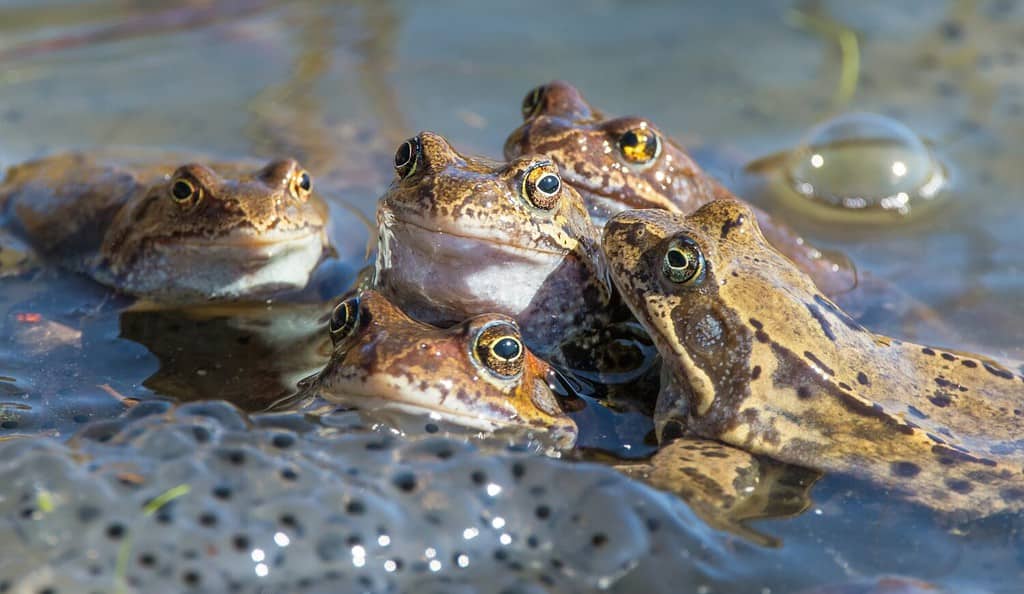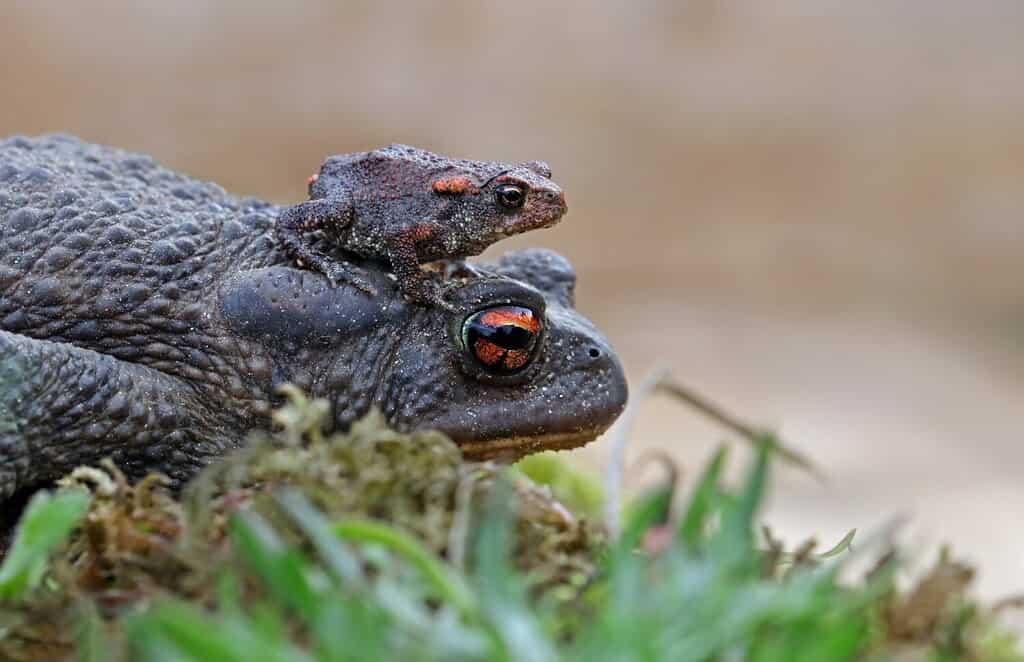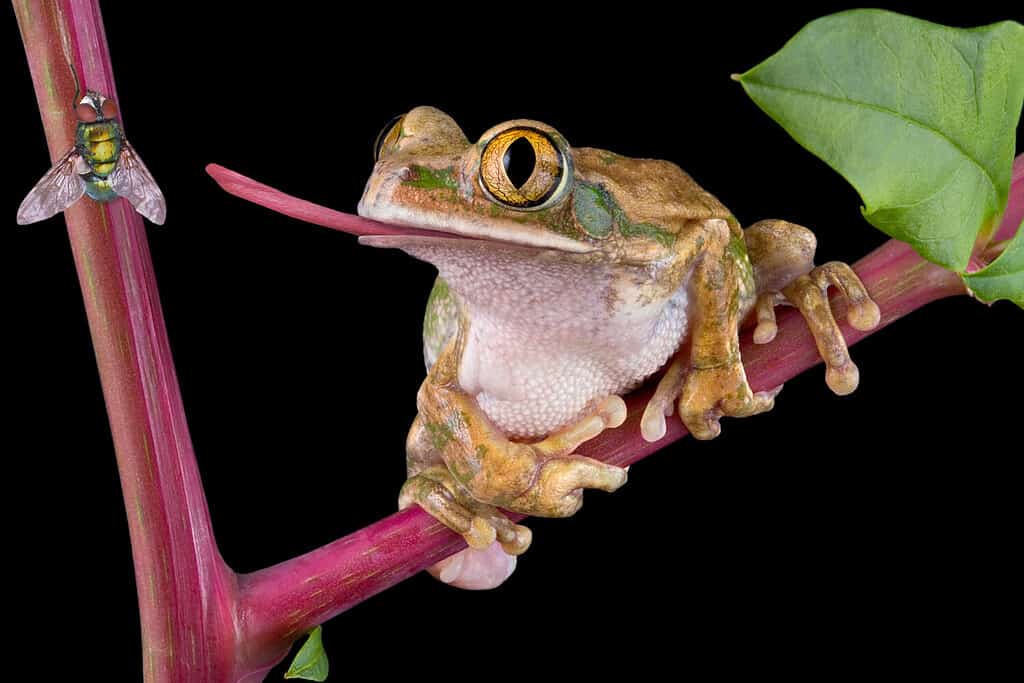A frog is an amphibian that belongs to the order Anura. Frogs are found in various habitats, from ponds and lakes to swamps and marshes. They can also be found in forests, grasslands, deserts, and even on mountains! Some frogs live near human settlements like cities or farms. Frogs are widely distributed around the world, with over 6,000 species living on all continents except Antarctica. Frogs have unique characteristics, such as webbed feet for swimming and jumping, due to their long legs. They have thin skins. This allows them to absorb water through their skin instead of drinking it like other animals do!
A Group of Frogs

When threatened by a predator, frogs will produce a loud croaking sound.
©Daniel Prudek/Shutterstock.com
A group of frogs is called an army, colony, or congregation. This name is very fitting for the amphibians as they are known to travel in large numbers. They are also known to congregate around water sources. They can often hop around together near ponds, rivers, and streams. Additionally, when threatened by a predator, frogs will produce a loud croaking sound. This creates what could almost be likened to an army cry.
Group Size
Frogs can be both solitary and social creatures, depending on the species. For example, some frog species are mainly solitary. Solitary frogs include tree frogs, which live in trees or ponds. Other frogs form groups to mate or protect themselves from predators. In general, however, frogs tend to prefer living alone. The exception is during the mating season when they come together in larger numbers. When this happens, a group of frogs is often called an army of frogs.
An army of frogs usually consists of a few dozen up to one hundred individuals. This relatively small number is due to the fact that frogs are not herd creatures, so they don’t form large groups like some other animals do. In general, an army of frogs will contain males and females in roughly equal numbers, but this ratio can vary from species to species depending on their mating habits. Because most frog species breed during certain times of the year or when water levels are favorable, it’s common for larger numbers of frogs to congregate at these times. Group sizes may range from just a few individuals up to one hundred or more.
Group Behavior

Furthermore, research has shown that in some species of frogs, there is a division of labor among group members
©Kurit afshen/Shutterstock.com
We do know something about the behavior of frogs in groups. Frogs tend to move together in large groups and rely on their collective movement to find food. They also display social behaviors such as vocalizing, chasing each other around, and grooming one another. In addition, they have a hierarchical social structure that is determined by size and strength – larger, more dominant frogs will often be at the center of a group. At the same time, smaller, less aggressive ones will remain on the periphery.
Furthermore, research has shown that in some species of frogs, there is a division of labor among group members. Certain individuals take up specific roles like foraging or defending against predators. Lastly, some studies suggest that when faced with difficult tasks (such as escaping from an enclosure), individual frog performance increases when they are part of a coordinated group compared to working alone.
Group Communication
Frogs are capable of complex communication, consisting of various vocalizations and visual cues. The most common form of communication is the call, which can be used to denote territory or attract mates. Certain species have specialized calls that contain information about size and sex. Choruses also play an important role in frog communication, as they create a sense of community within a group by forming synchronous chirps for long periods at dawn or dusk. Visual cues such as posture and body coloration can also convey messages between frogs without the need for vocalization. For example, some frogs will puff up their bodies to appear larger when threatened or display bright colors if they feel safe in their environment. Group communication is essential for many aspects of frog behavior, including mating rituals, predator avoidance strategies, and social interactions with other members of their species.
Courting and Mating

Visual cues such as posture and body coloration can also convey messages between frogs without the need for vocalization.
©Kurit afshen/Shutterstock.com
Frog courtship and mating typically occur in the spring or summer when temperatures rise and water levels are high. During this time, males will perform a variety of behaviors to attract females as part of their breeding ritual. This can include calling out with deep, low-pitched vocalizations, displaying vibrant colors on their bodies, flicking their tongues at potential mates, and performing complex acrobatics in the water. Once a female consents to the male’s advances, they will engage in amplexus—the act of physical embrace during which eggs are fertilized. Afterward, both parents may remain together for several days until the eggs hatch into tadpoles or pollywogs that look nothing like adult frogs!
Reproduction and Parenting
Frogs typically reproduce through the process of external fertilization, which involves a female frog releasing her eggs into the water and a male then fertilizing them with his sperm. The eggs are usually laid in large clumps containing hundreds to thousands of individual eggs. After being fertilized, these egg masses will develop into tadpoles over several weeks or months, depending on the species.
Frogs display a wide range of parenting behaviors, from constructing foam nests or ministering to their eggs to more elaborate forms, such as internally brooding their offspring or cooperating with each other to provide food for the young. Some species will even take turns incubating the eggs, while others may always guard them. In some cases, both parents will cooperate in bringing food to the tadpoles once they have hatched. This parental behavior is essential for ensuring that the froglets are provided with sustenance until they can care for themselves.
Group Hunting and Eating

In some cases, both parents will cooperate in bringing food to the tadpoles once they have hatched.
©Fercast/Shutterstock.com
Frogs hunt and eat in various ways, depending on the species. Some frogs are expert hunters, using their long tongues to catch prey like insects. Other frogs eat smaller animals that come into contact with them, including worms and spiders. Additionally, some frog species will scavenge for food by hunting for carrion or consuming plant material such as algae. Frogs also use teamwork when hunting. Groups of frogs can work together to locate food sources more easily than an individual frog alone could do. This is why it’s common to find multiple frogs in one area where plenty of food is available – they have learned how to work together as a group!
Traveling
Frogs generally travel to find suitable breeding grounds, food sources, and temperature conditions. Some species of frogs even migrate over long distances during their lifetime – for example, the cane toad (Bufo marinus) can migrate up to 12 miles in one year! Frogs will also travel short distances within their habitat when seeking out new feeding spots or places with better temperatures. In some cases, frogs have been known to use human-made pathways such as roads and trails when migrating from one area to another, so be careful where you drive!
Population and Conservation

Frogs also use teamwork when hunting.
©Cathy Keifer/Shutterstock.com
Frog populations around the world are facing a crisis. As a result of habitat destruction, climate change, and pollution, many frog species are in danger of extinction. In order to protect frogs from becoming extinct, conservation measures must be taken to ensure their survival. Conservation efforts include protecting wetlands and wetland habitats where frogs live. Many areas limit pesticide use and create buffer zones between urban areas and natural habitats. Another important action is in educating people about the importance of conserving wildlife species such as frogs. Additionally, scientists can work together to learn more about the ecology and behavior of threatened or endangered frog species to understand how best to protect them from further decline in population numbers.
The photo featured at the top of this post is © Milan Zygmunt/Shutterstock.com
Thank you for reading! Have some feedback for us? Contact the AZ Animals editorial team.






